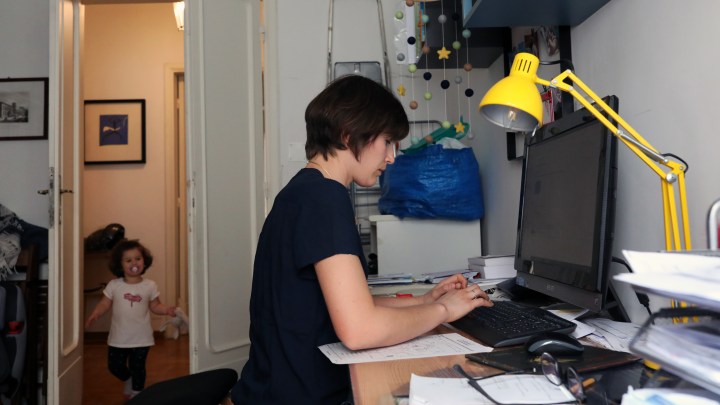
Women’s return to work a stop-and-start struggle

In the early days of the pandemic, a lot of parents left the workforce — especially mothers. Schools and day care centers were shut down, no one knew how safe kids were from COVID-19 and if folks had to stay home to care for family members, unemployment insurance was there to help. At least for a while.
Most of those parents are back at work, now that schools and day care centers are open again — but fewer women than men. According to data from the Bureau of Labor Statistics, there are 225,000 more men in the labor force now than before the pandemic, but 427,000 fewer women. Men have recovered all the jobs they lost in the pandemic; women are still down by 515,000 jobs compared to February 2020.
Returning to wage-earning work for many women starts with finding stable, affordable care for their kids.
Cindy’s Center for Young Learners is a home-based, nationally accredited child care center in Indianapolis. It’s got capacity for 16 kids, and it’s been at capacity for a while.
“I am doing my best to expand, to get a larger footprint,” said founder Cynthia Randolph-Vaughn, adding that demand is higher than she’s ever seen. She’s pulled back on advertising because she gets inundated with requests. “We’re definitely maxed out,” she said. “We have spots that are paid for for attendance next June and July.”
Meanwhile, Randolph-Vaughn struggles to hire new staff. And she pays around $20 per hour, well above the industry average of just over $13 per hour.
Nationwide, the child care industry is still far from having recovered, said Abby Copeman Petig of the Center for the Study of Child Care Employment at the University of California, Berkeley.
“We are still down about 1 in 10 child care jobs as compared with February of 2020,” she said. “So that’s a fairly significant loss of jobs and therefore loss of spaces.”
Finding full-time day care has allowed some women to return to full-time jobs. Liz Wertz’s 2-year-old son is at Cindy’s Center in Indianapolis. Wertz is a financial adviser and her husband is a video editor. Early in the pandemic, she stopped working full time to be home with her two kids.
About a year ago, she got a great job offer. They’d need day care — at more than $1,200 a month — but they decided it was worth it, Wertz said.
“It might be hard in the beginning just because of where our salaries are right now, but I have a pretty good future potential with my job.”
Still, it’s a challenge. She’s had to juggle responsibilities when her kids are sick or out of school. “Working full time in a male-dominated industry has added its own domestic care gap,” Wertz said. “It often falls majority on the woman to kind of clear her schedule or take off work.”
Those challenges have led a lot of women to partially pull back from the workforce, said Jasmine Tucker at the National Women’s Law Center. “Women are disproportionately likely to shift from full time to part time, and to do so to provide care for others.”
Sometimes that’s a choice — for women with enough income and child care options.
Neeraja Lammata lives in Brooklyn, New York, and has a 6-year-old in school and a 3-year-old in half-time day care. Her husband works in magazine publishing; she has a part-time job in food marketing.
“It’s been a fabulous way to have some of the pride you can take in work and your career,” Lammata said. “But at the same time, to sign off around 1:30 and say ‘OK, I’m going to switch back to mom mode now.’ COVID changed our perspective on why we work full time and how much time we want to spend with our kids.”
But sometimes going part time is more of a necessity.
Daniella Knight lives in Annapolis, Maryland. She has three young kids. Her husband works full time in litigation support while trying to finish his B.A. Knight went from juggling two jobs — property management and sleep consulting, which she describes as “more than full time” — to now just working one contract job.
“It’s not full time,” Knight said. “I’m not able to have — because we don’t have child care. The children get out of school at 2:40, there’s no after care.”
That’s one reason some women have dropped out of the workforce entirely since the pandemic hit, said economist Katherine Lim at the Minneapolis Federal Reserve Bank, who co-authored a recent report on the topic.
“Particularly among less educated couples,” Lim said, “there was a shift from dual-participant families to families with only one adult in the labor market. A substantial driver of this shift was women with kids, with caregiving responsibilities.”
By working a part-time job, Daniella Knight is trying to keep her hand in, to contribute to the family budget. But, she said, “it’s not easy. It’s not easy at all.”
Knight’s youngest child just started kindergarten. She’s not sure when she’ll be able to work — and earn — full time again.
There’s a lot happening in the world. Through it all, Marketplace is here for you.
You rely on Marketplace to break down the world’s events and tell you how it affects you in a fact-based, approachable way. We rely on your financial support to keep making that possible.
Your donation today powers the independent journalism that you rely on. For just $5/month, you can help sustain Marketplace so we can keep reporting on the things that matter to you.











